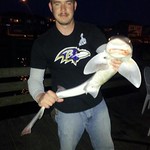| Spiny Dogfish Shark |  |
Spiny Dogfish Shark | | Squalus acanthias | (A.K.A. Sand Shark, Horned Dog, Piked Dogfish, Spurdog, Rock Shark, Rock Cod, & Rock Salmon)
| Key Distinguishing Markings:
- Single spine in front of each of their two dorsal
fins
- Second dorsal fin is smaller than the first but has a
larger spine
- Dogfish do not have an anal fin
- Slender with a depressed head and pointed snout
- Dorsal side is gray to brown and ventral side is pale
gray to white
- Iridescent blue-green coloration in pupils
- White spots on body
View the Dogfish Gallery
| Distribution:
- Spiny dogfish are found in the North Atlantic and North Pacific Oceans.
- Along the Atlantic coast, spiny dogfish are found from Labrador south to Florida but are most abundant from Nova Scotia to Cape Hatteras, North Carolina.
- In Maryland, spiny dogfish are most abundant from November to April.
| Size:
- To about 4.5 ft and males are normally smaller than females.
- Immature dogfish school by size and by sex when mature.
| Habitat:
- Spiny dogfish may be found in oceans and coastal zones but rarely enter the upper reaches of estuaries.
- They have been reported to enter freshwater but they cannot survive very long.
- Dogfish are found from the surface to 3,000 ft but are typically on the bottom.
- They prefer water temperatures around 45 - 55°F.
| Spawning:
- Females mature at about age 12 and are around 30".
- Males mature at about age 6 and are around 24".
- In the North Atlantic spawning occurs in the winter.
- Females are ovoviviparous (produce eggs that hatch within the body) and have a gestation period of 24 months, the longest of any vertebrate.
- Eggs for the next litter begin developing for fertilization concurrent with the litter.
- They generally have from 2 to 15 pups with an average of 6 pups.
- Pups are about 14" when they are born.
Management:
- National Marine Fisheries Service (NMFS) declared spiny dogfish as overfished in 1998 and rebuilt in 2009.
- The federal Spiny Dogfish Fisheries Management Plan (FMP) was fully implemented by the beginning of the 2000 – 2001 fishing year.
- In order to prevent overfishing in state waters, the Atlantic States Marine Fisheries Commission (ASMFC) Interstate FMP for Spiny Dogfish was approved in November 2002 and implemented for the 2003 – 2004 fishing year.
- Three addenda were implemented since passage of the Interstate FMP in 2002.
- Addendum I was approved in November 2005. It provided the Management Board with authority to establish specifications for up to five years.
- Addendum II was approved in October 2008. It replaced seasonal quotas with regional quotas and required regional payback of overages. Specifically, the Atlantic states from Maine south to North Carolina were broken down into three regions each with a percent of the total quota:
- Maine to Connecticut (Northern Region) 58%;
- New York to Virginia (Southern Region) 26%; and
- North Carolina 16%.
- Addendum III was approved in April 2011. It replaced the Southern Region and North Carolina quotas with state specific shares. The Northern Region receives 58% of the coastal quota and the remaining 42% is broken down in the following manner:
- New York 2.707%;
- New Jersey 7.644%
- Delaware 0.896%;
- Maryland 5.920%;
- Virginia 10.795%; and
- North Carolina 14.036%.
Quota overages are deducted from the appropriate region or state in the next fishing season. States not included in the Northern Region may transfer quota. The recipient of transferred quota is responsible for any overages. Up to 5% of unused quota, inclusive of transferred quota, may be rolled over to the next fishing season. With the exception of the Northern Region, states set their own possession limits. The Management Board sets possession limits for the Northern Region. These terms expire in three years unless extended by the Management Board.
Commercial Fishery
- In Maryland, gill nets and trawls are the primary gears used to capture dogfish.
- The fishing year for spiny dogfish does not follow the typical calendar year. Instead, it begins on May 1 and ends April 30th.

| Fishing Tips:
- This is a species that is described by recreational fishers as "undesirable."
- The gregarious nature of this shark usually results in multiple catches once the first one has been caught.
- The spiny dogfish is usually released by recreational anglers.
- For current recreational size and creel limits, see Maryland's updated regulation page.
| Fun Fact:
- It is the shark's gregarious nature, occurring in 'packs' of hundreds or thousands of individuals that explains where the 'dogfish' comes from in their common name.
- Some researchers have estimated the life expectancy of this shark to be 40 years (Atlantic).
- In Europe, if you order "fish & chips", you will probably be eating spiny dogfish.
- Watch out for those two dorsal spines, they are mildly venomous.
- Dogfish are eaten by whales, dolphins, weakfish, bluefish, striped bass and other large predators.
Kingdom: Animalia - animals
Phylum: Chordata - chordates
Subphylum: Vertebrata - vertebrates
Subclass: Elasmobranchii – cartilaginous fishes, rays, sharks, skates, torpedoes
Superorder: Euselachii
Genus: Squalus Linnaeus, 1758 – spiny dogfish, spurdogs
Species: Squalus acanthias Linnaeus, 1758 – piked dogfish, spiny dogfish
| | Family: Squalidae Blainville, 1816 –dogfish sharks, spiny dogfishes | | Order: Squaliformes Compagno, 1973 – dogfish sharks | | Class: Chondrichthyes – cartilaginous fishes, rays, sharks | For information concerning spiny dogfish shark and their management, please contact Angel Willey.
Illustration courtesy of the Maine Department of Marine Resources, Recreational Fisheries Program and the Maine Outdoor Heritage Fund
Photo of Spiny Dogfish courtesy of NOAA
|
|
